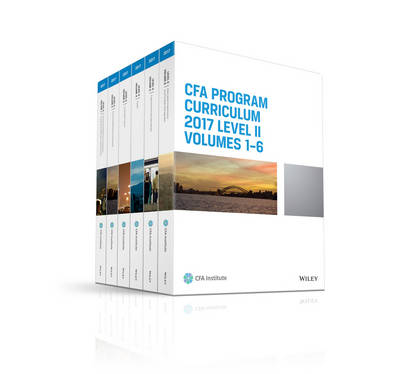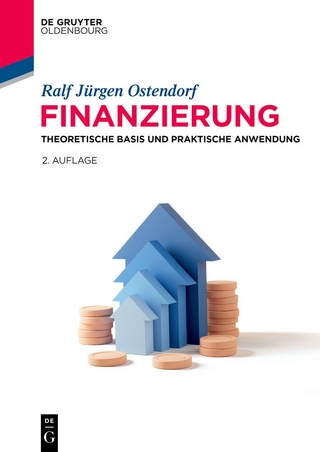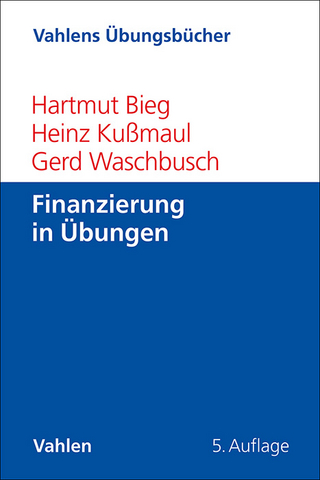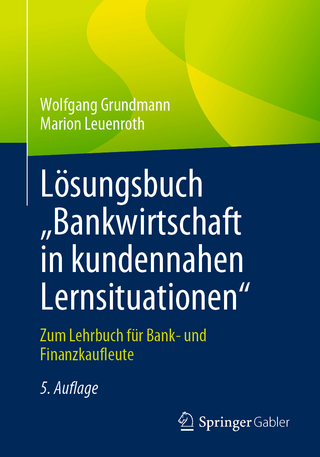
CFA Program Curriculum 2017 Level II, Volumes 1 – 6
American Institute of Certified Public Accountants (Verlag)
978-1-942471-86-8 (ISBN)
- Titel erscheint in neuer Auflage
- Artikel merken
The same official curricula that CFA Program candidates receive with program registration is now publicly available for purchase. CFA Program Curriculum 2017 Level II, Volumes 1–6 provides the complete Level II Curriculum for the 2017 exam, with practical instruction on the Candidate Body of Knowledge (CBOK) and how it is applied, including expert guidance on incorporating concepts into practice. Level II focuses on complex analysis with an emphasis on asset valuation, and is designed to help you use investment concepts appropriately in situations analysts commonly face. Coverage includes ethical and professional standards, quantitative analysis, economics, financial reporting and analysis, corporate finance, equities, fixed income, derivatives, alternative investments, and portfolio management organized into individual study sessions with clearly defined Learning Outcome Statements. Charts, graphs, figures, diagrams, and financial statements illustrate complex concepts to facilitate retention, and practice questions with answers allow you to gauge your understanding while reinforcing important concepts.
While Level I introduced you to basic foundational investment skills, Level II requires more complex techniques and a strong grasp of valuation methods. This set dives deep into practical application, explaining complex topics to help you understand and retain critical concepts and processes.
Incorporate analysis skills into case evaluationsMaster complex calculations and quantitative techniquesUnderstand the international standards used for valuation and analysisGauge your skills and understanding against each Learning Outcome Statement
CFA Institute promotes the highest standards of ethics, education, and professional excellence among investment professionals. The CFA Program Curriculum guides you through the breadth of knowledge required to uphold these standards. The three levels of the program build on each other. Level I provides foundational knowledge and teaches the use of investment tools; Level II focuses on application of concepts and analysis, particularly in the valuation of assets; and Level III builds toward synthesis across topics with an emphasis on portfolio management.
How to Use the CFA Program Curriculum ix
Curriculum Development Process ix
Organization of the Curriculum x
Features of the Curriculum x
Designing Your Personal Study Program xi
Feedback xiii
Ethical and Professional Standards
Study Session 1 Ethical and Professional Standards 3
Reading 1 Code of Ethics and Standards of Professional Conduct 5
Preface 5
Evolution of the CFA Institute Code of Ethics and Standards of Professional Conduct 6
Standards of Practice Handbook 6
Summary of Changes in the Eleventh Edition 7
CFA Institute Professional Conduct Program 9
Adoption of the Code and Standards 10
Acknowledgments 10
Ethics and the Investment Industry 11
Why Ethics Matters 11
CFA Institute Code of Ethics and Standards of Professional Conduct 15
Preamble 15
The Code of Ethics 15
Standards of Professional Conduct 16
Reading 2 Guidance for Standards I VII 21
Standard I: Professionalism 21
Standard I(A) Knowledge of the Law 21
Guidance 21
Recommended Procedures for Compliance 26
Application of the Standard 27
Standard I(B) Independence and Objectivity 30
Guidance 30
Recommended Procedures for Compliance 35
Application of the Standard 36
Standard I(C) Misrepresentation 43
Guidance 43
Recommended Procedures for Compliance 46
Application of the Standard 48
Standard I(D) Misconduct 53
Guidance 53
Recommended Procedures for Compliance 54
Application of the Standard 54
Standard II: Integrity of Capital Markets 56
Standard II(A) Material Nonpublic Information 56
Guidance 56
Recommended Procedures for Compliance 60
Application of the Standard 63
Standard II(B) Market Manipulation 68
Guidance 68
Application of the Standard 69
Standard III: Duties to Clients 73
Standard III(A) Loyalty, Prudence, and Care 73
Guidance 73
Recommended Procedures for Compliance 77
Application of the Standard 78
Standard III(B) Fair Dealing 82
Guidance 82
Recommended Procedures for Compliance 84
Application of the Standard 86
Standard III(C) Suitability 90
Guidance 90
Recommended Procedures for Compliance 93
Application of the Standard 94
Standard III(D) Performance Presentation 97
Guidance 97
Recommended Procedures for Compliance 98
Application of the Standard 98
Standard III(E) Preservation of Confidentiality 101
Guidance 101
Recommended Procedures for Compliance 103
Application of the Standard 103
Standard IV: Duties to Employers 105
Standard IV(A) Loyalty 105
Guidance 105
Recommended Procedures for Compliance 109
Application of the Standard 109
Standard IV(B) Additional Compensation Arrangements 116
Guidance 116
Recommended Procedures for Compliance 116
Application of the Standard 116
Standard IV(C) Responsibilities of Supervisors 118
Guidance 118
Recommended Procedures for Compliance 120
Application of the Standard 122
Standard V: Investment Analysis, Recommendations, and Actions 126
Standard V(A) Diligence and Reasonable Basis 126
Guidance 126
Recommended Procedures for Compliance 130
Application of the Standard 130
Standard V(B) Communication with Clients and Prospective Clients 137
Guidance 138
Recommended Procedures for Compliance 140
Application of the Standard 141
Standard V(C) Record Retention 146
Guidance 146
Recommended Procedures for Compliance 147
Application of the Standard 148
Standard VI: Conflicts of Interest 149
Standard VI(A) Disclosure of Conflicts 149
Guidance 149
Recommended Procedures for Compliance 152
Application of the Standard 152
Standard VI(B) Priority of Transactions 157
Guidance 157
Recommended Procedures for Compliance 158
Application of the Standard 160
Standard VI(C) Referral Fees 162
Guidance 162
Recommended Procedures for Compliance 162
Application of the Standard 162
Standard VII: Responsibilities as a CFA Institute Member or CFA Candidate 165
Standard VII(A) Conduct as Participants in CFA Institute Programs 165
Guidance 165
Application of the Standard 167
Standard VII(B) Reference to CFA Institute, the CFA Designation, and the CFA Program 170
Guidance 170
Recommended Procedures for Compliance 174
Application of the Standard 174
Practice Problems 177
Solutions 196
Reading 3 CFA Institute Research Objectivity Standards 209
Guiding Principles 209
Comparison with the New York Stock Exchange and National Association of Securities Dealers Rules 210
Overview of the CFA Institute Research Objectivity Standards 210
Definitions 211
Investment Banks, Broker–Dealers
and Other Firms That Sell Research 213
Requirements 213
Recommended Procedures for Compliance 215
Practice Problems 222
Solutions 224
Study Session 2 Ethical and Professional Standards: Application 225
Reading 4 The Glenarm Company 227
Case Facts 227
Sherman s Background 227
Glenarm 228
The Transition 228
Case Discussion 229
Loyalty to One s Employer 229
Disclosure of Additional Compensation and Conflicts 230
Reading 5 Preston Partners 233
Case Facts 233
Case Discussion 235
Responsibilities to Clients and Interactions with Clients 235
Allocation of Trades 236
Responsibilities of Supervisors 237
Reading 6 Super Selection 239
Case Facts 239
Case Discussion 240
Responsibilities of Supervisors 241
Employees and the Employer/Supervisor 241
Reasonable Basis 242
Duties to Clients 242
Investment Recommendations and Actions 243
Priority of Transactions 243
Reading 7 Trade Allocation: Fair Dealing and Disclosure 245
Reading 8 Changing Investment Objectives 249
Quantitative Methods
Study Session 3 Quantitative Methods for Valuation 253
Reading 9 Correlation and Regression 255
Introduction 256
Correlation Analysis 256
Scatter Plots 256
Correlation Analysis 257
Calculating and Interpreting the Correlation Coefficient 260
Limitations of Correlation Analysis 262
Uses of Correlation Analysis 265
Testing the Significance of the Correlation Coefficient 273
Linear Regression 276
Linear Regression with One Independent Variable 276
Assumptions of the Linear Regression Model 280
The Standard Error of Estimate 282
The Coefficient of Determination 285
Hypothesis Testing 287
Analysis of Variance in a Regression with One Independent Variable 295
Prediction Intervals 298
Limitations of Regression Analysis 301
Summary 301
Practice Problems 304
Solutions 313
Reading 10 Multiple Regression and Issues in Regression Analysis 317
Introduction 318
Multiple Linear Regression 318
Assumptions of the Multiple Linear Regression Model 324
Predicting the Dependent Variable in a Multiple Regression Model 329
Testing whether All Population Regression Coefficients Equal Zero 331
Adjusted R2 333
Using Dummy Variables in Regressions 334
Violations of Regression Assumptions 338
Heteroskedasticity 339
Serial Correlation 345
Multicollinearity 349
Heteroskedasticity, Serial Correlation, Multicollinearity: Summarizing the Issues 352
Model Specification and Errors in Specification 353
Principles of Model Specification 353
Misspecified Functional Form 354
Time–Series
Misspecification (Independent Variables Correlated with Errors) 363
Other Types of Time–Series
Misspecification 366
Models with Qualitative Dependent Variables 366
Summary 369
Practice Problems 373
Solutions 391
Reading 11 Time–Series Analysis 401
Introduction to Time–Series Analysis 402
Challenges of Working with Time Series 404
Trend Models 405
Linear Trend Models 405
Log–Linear
Trend Models 408
Trend Models and Testing for Correlated Errors 414
Autoregressive (AR) Time–Series Models 415
Covariance–Stationary Series 416
Detecting Serially Correlated Errors in an Autoregressive Model 417
Mean Reversion 420
Multiperiod Forecasts and the Chain Rule of Forecasting 421
Comparing Forecast Model Performance 424
Instability of Regression Coefficients 426
Random Walks and Unit Roots 429
Random Walks 429
The Unit Root Test of Nonstationarity 433
Moving–Average
Time–Series
Models 437
Smoothing Past Values with an n–Period Moving Average 438
Moving–Average
Time–Series
Models for Forecasting 440
Seasonality in Time–Series Models 442
Autoregressive Moving–Average Models 448
Autoregressive Conditional Heteroskedasticity Models 449
Regressions with More than One Time Series 452
Other Issues in Time Series 456
Suggested Steps in Time–Series Forecasting 456
Summary 458
Practice Problems 461
Solutions 471
Reading 12 Excerpt from Probabilistic Approaches: Scenario Analysis, Decision Trees, and Simulations 477
Introduction 477
Simulations 478
Steps in Simulation 478
An Example of a Simulation 481
Use in Decision Making 484
Simulations with Constraints 485
Issues 486
Risk–Adjusted Value and Simulations 487
An Overall Assessment of Probabilistic Risk Assessment Approaches 488
Comparing the Approaches 488
Complement or Replacement for Risk–Adjusted Value 489
In Practice 490
Conclusion 491
Economics
Study Session 4 Economics for Valuation 495
Reading 13 Currency Exchange Rates: Determination and Forecasting 497
Introduction 498
Foreign Exchange Market Concepts 500
Arbitrage Constraints on Spot Exchange Rate Quotes 503
Forward Markets 507
A Long–Term Framework for Exchange Rates 516
International Parity Conditions 518
Assessing an Exchange Rate s Equilibrium Level 535
Tying It Together: A Model That Includes Long–Term Equilibrium 538
The Carry Trade 539
The Impact of Balance of Payments Flows 543
Current Account Imbalances and the Determination of Exchange Rates 543
Capital Flows and the Determination of Exchange Rates 547
Monetary and Fiscal Policies 555
The Mundell Fleming Model 555
Monetary Models of Exchange Rate Determination 558
The Taylor Rule and the Determination of Exchange Rates 559
Monetary Policy and Exchange Rates The Historical Evidence 561
Fiscal Policy and the Determination of Exchange Rates 565
Exchange Rate Management: Intervention and Controls 567
Currency Crises 572
Shorter–Term Forecasting Tools 575
Technical Analysis 576
Order Flow, Sentiment, and Positioning 578
Summary 581
Appendix 587
Practice Problems 588
Solutions 593
Reading 14 Economic Growth and the Investment Decision 597
Introduction 598
Growth in the Global Economy: Developed vs. Developing Countries 598
Savings and Investment 601
Financial Markets and Intermediaries 601
Political Stability, Rule of Law, and Property Rights 602
Education and Health Care Systems 602
Tax and Regulatory Systems 603
Free Trade and Unrestricted Capital Flows 603
Summary of Factors Limiting Growth in Developing Countries 604
Why Potential Growth Matters to Investors 606
Determinants of Economic Growth 611
Production Function 611
Capital Deepening vs. Technological Progress 613
Growth Accounting 615
Extending the Production Function 617
Natural Resources 617
Labor Supply 619
Labor Quality: Human Capital 624
Capital: ICT and Non–ICT 625
Technology 627
Public Infrastructure 631
Summary 631
Theories of Growth 636
Classical Model 637
Neoclassical Model 637
Endogenous Growth Theory 649
Convergence Debate 652
Growth in an Open Economy 656
Summary 664
Practice Problems 668
Solutions 675
Reading 15 Economics of Regulation 679
Introduction 679
Overview of Regulation 680
Classification of Regulations and Regulators 680
Economic Rationale for Regulation 683
Regulatory Tools 686
Regulation of Commerce 691
Regulation of Financial Markets 695
Cost Benefit Analysis of Regulation 696
Analysis of Regulation 698
Effects of Regulations 700
Summary 703
Practice Problems 706
Solutions 708
Appendices 709
Glossary G–1
Index I–1
| Erscheinungsdatum | 04.10.2016 |
|---|---|
| Reihe/Serie | CFA Curriculum 2017 |
| Verlagsort | NC |
| Sprache | englisch |
| Maße | 230 x 290 mm |
| Gewicht | 6200 g |
| Themenwelt | Wirtschaft ► Betriebswirtschaft / Management ► Finanzierung |
| ISBN-10 | 1-942471-86-6 / 1942471866 |
| ISBN-13 | 978-1-942471-86-8 / 9781942471868 |
| Zustand | Neuware |
| Haben Sie eine Frage zum Produkt? |
aus dem Bereich



